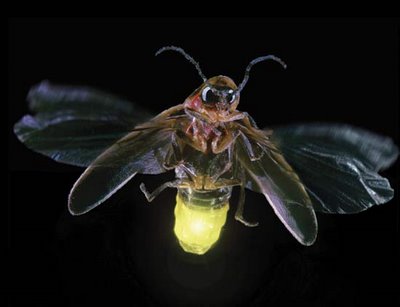 i
i
It’s debatable, but perhaps fireflies might have been the inspiration Edison used to create the light bulb. Nevertheless, fireflies have not only fascinated admirers at night, but scientists as well. Recently, science has used the microscopic structure of the firefly’s light emitting structure to improve LED output, making LEDs more efficient and higher in brightness.
OK….Now for the biology and chemistry lesson. Many of the basic principles are shared between fireworks and bioluminesence. Chemical reactions add energy to molecules to excite electrons which, as a result, emit light of certain wavelengths depending on their structure as they return to ground state. There are also major differences. The chemicals involved are not metals or metal salts in biological organisms as they are in fireworks, but rather organic molecules in a class known as, “luciferins”. Alongside the luciferins are a special class of enzymes called, “luciferases”. These two classes of chemicals represent the agic light of biology.

What does the bioluminescent luciferins have to do with improving LED technology?………….Nothing……at least not directly.
It’s more about the structure of the firefly’s abdomen that is key. New research has found that LEDs that use firefly-inspired lenses need less energy to shine brighter. Scientists have created a lens for LEDs that is etched with tiny dots, similar to how a firefly’s “lantern” is covered in tiny ridges. The lens allows 98 percent of light to pass through it, which is significantly better than a traditional lens.

Ki-Hun Jeong of the Korea Advanced Institute of Science and Technology and colleagues studied firefly abdomens under a scanning electron microscope. They found the lantern part of the abdomens is made of three layers, and bears a striking resemblance to a standard LED bulb. Who would have thunk it?

A standard LED is made of a reflective “cup” and a lens on either end of the actual light source. Similarly, a firefly’s lantern is made of a reflective layer, a light-emitting layer and a cuticle layer, or exoskeleton, covered in tiny ridges. These ridges when seen up close are the most organized patterned structures of the firefly.
Jeong and his team were successful in creating a higher emittence of light by etching these patterns into plastic. This new lens indeed increased the output by allowing a greater amount of that particular wavelength of light to pass through. The researchers used nanopillars packed into the shape of a honeycomb, rather than the firefly’s long ridges. But just like a real firefly, the patterns seemed to work best when the light had a wavelength of 560 nanometers, or the familiar yellow-green glow of a lightning bug.
So what are the implications of this discovery? The technique could be used to boost light for camera phone screens or flashes, car headlights, or even just residential lighting, the researchers say.





